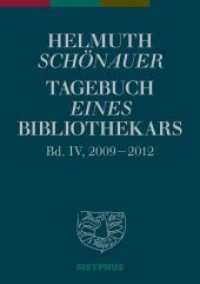- ホーム
- > 洋書
- > ドイツ書
- > Humanities, Arts & Music
- > Psychology
- > theoretical psychology
Full Description
This book tries to answer some intriguing questions concerning the power of agoral gatherings. The 20th century is discussed as an age of crowds and masses. The book asks why the communist system disappeared in Europe during the last two decades of the 20th century and examines the factors which determined the collapse of the main military, political, social, economic and even symbolic infrastructures of the communist system in Europe. It poses the question why the end of communism in Europe was a peaceful phenomenon - except in the Balkan Peninsula. The author also discusses the predictability of this kind of phenomenon. In order to answer these questions the book introduces and extends the notion of agoral gathering as a new concept in the area of collective behavior and interprets the large-scale political transformations in Central and Eastern Europe in the 1990s in terms of peaceful collective behaviors as a political alternative for post-communist countries.
Contents
Contents: Adam Biela: Agoral Gatherings which Have Changed the Political Face of Central and Eastern Europe - Jan Ferjenčik: Psychosocial Analysis of the Agoral Gatherings that Took Place During the Velvet Revolution in Czechoslovakia - Eva Naništová: Retrospective and Current Approaches to the Velvet Revolution in Slovakia - Grzegorz Kida: Towards the Social and Cognitive Model of Macro Transformations in Poland - Piotr Andrukiewicz: Pilgrimages as Agoral Gatherings: A Case Study of the Pilgrimage to Częstochowa in Poland - Mariusz Wołońciej: The Power of Narratives Steering Collective Memory: The Cultural Aspects of Agoral Gatherings.







